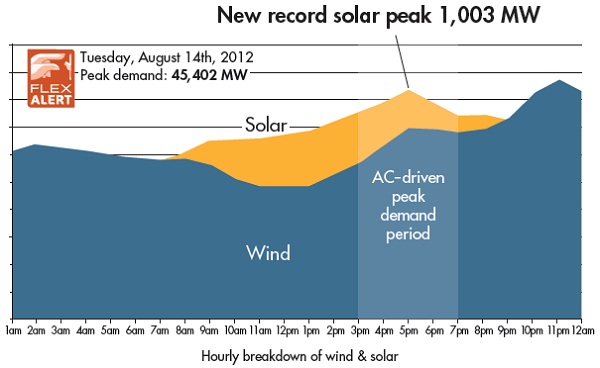Topping 1 gigawatt in solar power production on a hot August day was a milestone that both shows how far California has come with solar power and how far it has to go.
The California Independent System Operator (CAISO), which runs the state’s grid, said the state cracked 1 GW for the first time and hit a utility-scale solar generation peak of 1,003 megawatts on Tuesday, Aug. 14.

That record of 1,003 MW has since been broken several times, with the latest high-water (high-sunlight?) mark coming on Friday, Aug. 31, at 1,076 MW. CAISO says 1 megawatt can meet the instantaneous demand of at least 750 homes, so in these instances solar was powering more than 750,000 California homes.
Peak output is just a snapshot in time, however, and solar’s climb over the 1 GW barrier invites a closer look at how solar fits into the Golden State’s energy picture. Let’s go back to that Aug. 14 day to get a sense of that.
Solar generating stations began to trickle power onto the grid around 6 a.m. Production climbed throughout the morning, and peaked around 1 p.m. It began to slide very slowly in the next couple hours, off 10 percent by 3 p.m., then took a steeper drop. By 6 p.m. it was down half of what it was six hours earlier. By midnight, the last, lingering solar-inspired electrons had moved.
It all added up to 8,843 megawatt-hours of electricity flowing onto the grid – out of 869,26 MWh of electricity used by Californians that day. That means wholesale solar accounted for almost exactly 1 percent of the day’s electricity demand. (Wind power, meanwhile, met 3.7 percent of the day’s electricity demand.)

This makes the point, if it wasn’t obvious, that solar has a great distance to travel before it can be seen as a big contributor in meeting California’s electricity needs. But it’s hardly enough to dismiss solar, for a couple of reasons.
First, go back to Aug. 14, 2010, and on that day, you’ll find solar’s contribution to the grid to be less than three-fifths what it was on Aug. 14, 2012. From 0.6 percent to 1 percent of total generation might small, but it’s a big jump in just two years, and with several utility-scale plants in development — giant ones like Solar Ranch One in the Antelope Valley and Ivanpah in the Mojave Desert, and many smaller ones, too — there’s no reason to think growth want continue at a fast or even accelerating pace.
Plus, remember, we’re talking only about wholesale solar here. California also has more than 1 gigawatt of solar capacity behind meters – on the roofs of businesses and homes all over the state – that isn’t included in the California ISO totals. As Vote Solar noted, “when you add the 1.2 GW and counting of customer-owned solar generation that serves onsite load, the total more than doubles.” And that total is growing fast, too.